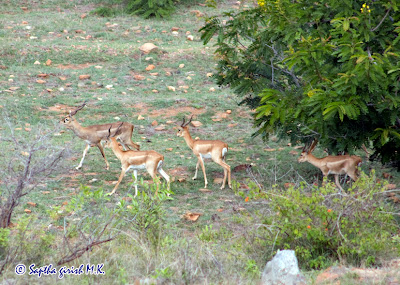Sorry that I didn’t update the blog all these days, underwent a minor surgery and was recuperating from it.
I would first like to introduce our team.
The team comprises of Mahesh, Kumar, Manu, Hemanth, Guruprasad B.S and me (Ajay).
It all started when Kumar & Mahesh came across a Technical report prepared by Mr.H.N.Kumara et.al. about a Biodiversity Conservation Plan for Mysore Forest Division which mentioned the indirect evidence of blackbucks in a place called Konanoor in Nanjangud taluk of Mysore district just about 36 kms from the bustling city of Mysore. They personally visited the site with Mr. Sapthagirish M.K.,who was on the team that prepared the technical report and confirmed about the presence of blackbuck population in that area. They had seen a herd of seven male sub adults very peacefully grazing around.
Mysore region had lost its blackbuck population at least six decades ago due to hunting, habitat loss and urbanization. The last hunting records by the Maharajas of Mysore date back to the forties. Then the populations was as near as twelve kilometers from the palace of Mysore. In fact a hostel block in the prestigious Sri Jayachamarajendra college of Engineering was once a hunting bungalow. Records say the Maharajas hunted Black bucks here. Alas those days are only history.
Today it is difficult to even convince this fact to anybody. Even according to the knowledge of the Dept. of forests, the rediscovery of Black bucks in Mysore was unbelievable.
We re-visited Konanoor and sighted these creatures and a thought of doing our bit to conserve these wonderful creatures came up. We then looked up for other available material and got a rough idea about the historical distribution and habitat requirements of these animals. We made a lot of enquiry about their present distribution. We were surprised to notice that large population of blackbucks existed outside protected areas else where in Karnataka. Another of Kumara’s report on the survey of Large mammals in Karnataka also re-affirmed the fact. Friends from Koppal, Tiptur and Hassan also reported their encounter with stable herds of blackbucks in their vicinity.
Our reasoning bothered a lot. How did they reach out to these new destinations? Had they been there always and is it that they are coming to light only now? The more intriguing question was will they survive in such small pockets of grasslands which are non-protected?
Even though the dept. of forests puts in conservation efforts inside the protected areas, there are little funds and man power to undertake conservation efforts in the non protected areas. So we felt that there is a need to device an alternate conservation plan in such situations.
In these days of rapid decline in habitats more and more species are drifting into situations that give rise to constant conflicts with local communities. On the other hand we also witness very just and compassionate communities that have taken care of wild populations with very little in return. How or why do they do it? Probably the communities must have a longer foresight which surpassed any materialistic gains.
The Bishnoi community of Rajastan is well known for their compassion towards animals and their forests. The village of Keichen is also a text book example of sharing their produce with migratory birds. More familiar is our own pelican village of Kokkare Bellur where the noisy and smelly fish-eating birds share the back yards of the farmers.
These cases impressed us hugely and the thought of community based conservation might work dawned in us. Even as the Conservationists are divided about the issue we simply felt that one must consider the species, the community and the type of interaction between them to work out. So as a first step we decided to get into Conservation Education in the locality. Approaching the community through schools seems one good working model in our country as the target audiences are the future custodians of this world.


No comments:
Post a Comment